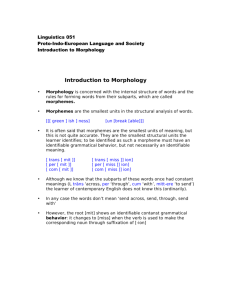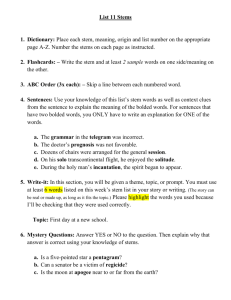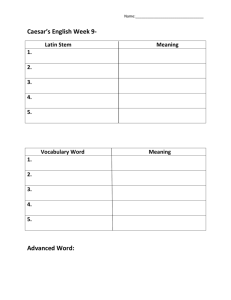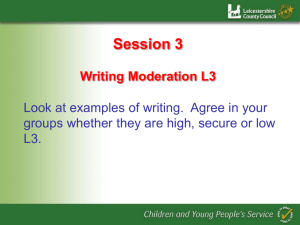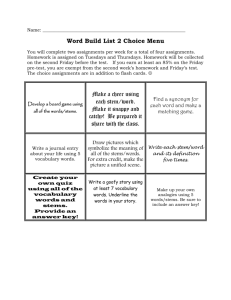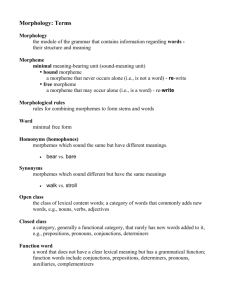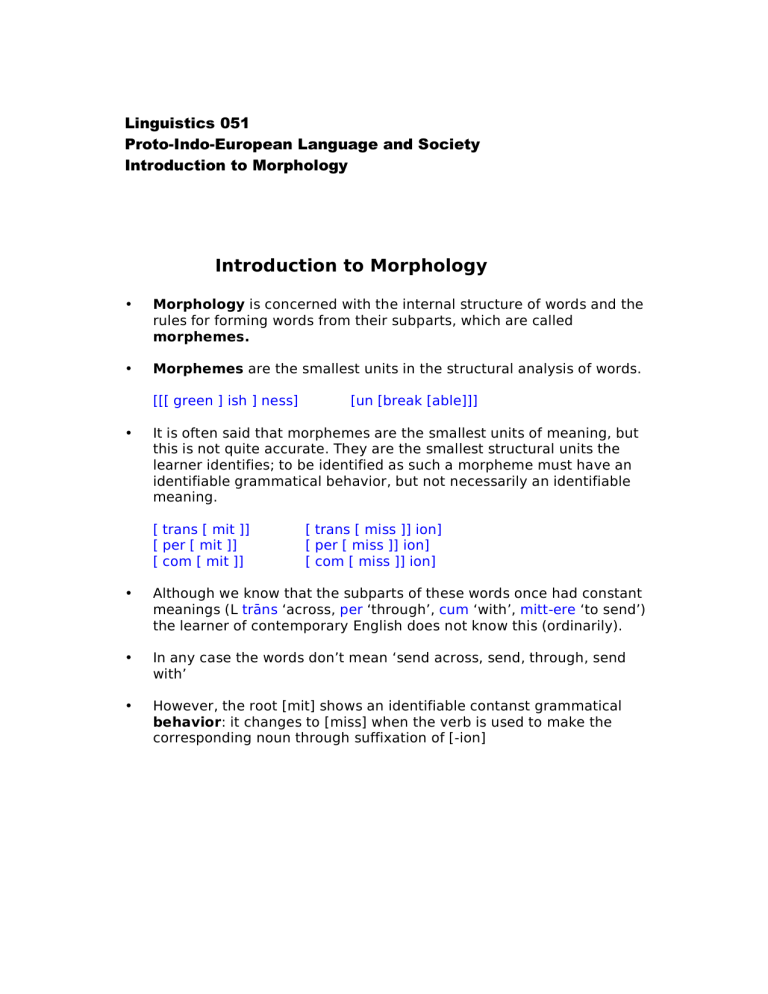
Linguistics 051 Proto-Indo-European Language and Society Introduction to Morphology Introduction to Morphology • Morphology is concerned with the internal structure of words and the rules for forming words from their subparts, which are called morphemes. • Morphemes are the smallest units in the structural analysis of words. [[[ green ] ish ] ness] • [un [break [able]]] It is often said that morphemes are the smallest units of meaning, but this is not quite accurate. They are the smallest structural units the learner identifies; to be identified as such a morpheme must have an identifiable grammatical behavior, but not necessarily an identifiable meaning. [ trans [ mit ]] [ per [ mit ]] [ com [ mit ]] [ trans [ miss ]] ion] [ per [ miss ]] ion] [ com [ miss ]] ion] • Although we know that the subparts of these words once had constant meanings (L trāns ‘across, per ‘through’, cum ‘with’, mitt-ere ‘to send’) the learner of contemporary English does not know this (ordinarily). • In any case the words don’t mean ‘send across, send, through, send with’ • However, the root [mit] shows an identifiable contanst grammatical behavior: it changes to [miss] when the verb is used to make the corresponding noun through suffixation of [-ion] 2 Open and Closed Class Items • Morphemes are divided into two types: open class and closed class • Open class items belong to categories/types to which new members may be freely added • For example, you certainly don’t know all the ‘nouns’ in English, and even if you did, new words come into use all the time to refer to things recently created, discovered or named: quark, google, blog, tweet, grunge • Closed class items on the other hand belong to categories/types to which new members cannot be added • For example, plural agreement in English is normally expressed with [s], as is 3rd person singular present tense agreement. • The agreement morphemes are a closed class: new agreement morphemes cannot be added to an adult’s grammar. • Similarly the modal verbs do, did, have, be, may, might, shall, should, will, would, can, could, ought form a closed class in English. These are the only verbs which can precede negation not or n’t in Modern English: I did not see the movie. *I saw not the movie (archaic) I (should) think not! (‘frozen’ expression: cannot be altered) *I think not the movie was worth seeing. Closed class items are often called ‘functional’ items because they typically have a grammatical function such as showing agreement, or marking or changing the category of other items to which they attach. [[quark] s] [[google] ed] [[tweet] ing] [[grunge] y ] ness] Inversely, open class items are sometimes called lexical because they form part of a vocabulary that must be memorized. (This use of lexicon to mean open-class vocabulary differs from some other uses of the term, however!) 3 Roots, stems and affixes • • • • • • Roots are the innermost constituents of words A stem is anything to which another morpheme may be added and which has a syntactic category such as noun or verb An affix is any non-root morpheme which attaches to another morpheme. A suffix is an affix which attaches to the right. A prefix is an affix which attaches to the left. An infix is an affix which is inserted inside of a root or stem. In English many roots are equivalent to stems. These are root-stems, and affixes attach directly to them: [[cat] s] [[put] s] [[laugh] ed] •In most languages, however, roots and stems are usually distinct. A root will become a stem by the addition of a stem formative morpheme. stem stem root formative | [[muchach] o] ‘boy’ root formative affix | | [[[muchach] o ] s] ‘boys’ [[muchach] a] ‘girl’ [[[muchach] a] s] ‘girls’ [[[habl] a] s] [[[habl] a] mos] ‘you sg. speak’ ‘we speak’ Compounds • Compounds are words which contain more than one root. [[ape][man]] • [[yellow-][green]] [[dog]-[[catch] er]] In languages with stem formatives a compound may be composed of two stems: [[Aff] en] [mensch]] ape person ‘apeman’ [[Hund] e] [[müd] e]] ‘dog-tired’ dog tired NHG is like English in that some roots can be stems alone; in other cases an overt stem formative appears. 4 Proto-Indo-European Word Structure • Any open class item (noun, adjective, verb) in PIE contains at least one root. • Ordinarily a root becomes a stem through the addition of a stemformative suffix. • The final suffix of a word usually indicates grammatical properties such as person, number, or case. This final suffix is called the ending or desinence. Schema [[R+S]+E] Root + Stem-Formative Suffix + Ending Example nouns and adjectives R *h₃rēg *h₂ner *k̑uon *h₂ou *bʰāg̑ʰ *esh₂ *oudʰ *sah₂ • • • • S Ø Ø Ø i u r es ul E s ‘king’ s ‘man, hero’ s ‘dog’ s ‘sheep’ s ‘forearm’ Ø ‘blood’ Ø ‘udder’ Ø ‘sun’ R *neu *ulkʷ *iug *ek̑ *h₂rt *g̑rh₂ *h₂ag̑ *h₂arh₁ S o o o uo k̑o no ro tro E s s m s s s s m ‘new’ ‘wolf’ ‘yoke’ ‘horse’ ‘bear’ ‘grain’ ‘field’ ‘plow’ Stems fall into two types: athematic and thematic Thematic stems end in a vowel (ordinarily *e/*o) Athematic stems end in a consonant or high vocoid (*i *u) The stems on the left above are athematic and on the right, thematic Some common noun and adjective stem-forming suffixes ACTION NOUNS: -o-, -(e)h₂-, -m(e)n, -(e)s-, -ti-, -tu-, -tr/n-, -r/n-, -ur/n-, -i(e)h₂AGENT NOUNS: -ó-, -tér-, -mén-, -ésINSTRUMENT NOUNS: -tro- ~ -tlo- ~ -dʰro- ~ -dʰloADJECTIVES OF APPURTENANCE: -o-, -io-, -no-, -k ̑o-, -ro-, -loADJECTIVES OF POSSESSION: -to-, -uo-, -u(e)ntADJECTIVES OF CHARACTERISTIC: -(e)n-, -h₁(e)n *bʰel- ‘to bloom’ : *bʰol-i̯o-m ‘flower’ (L folium) FOLIO *dei- ‘to shine’ : *dei-u̯o-s ‘god’ (L deus) DEIFY *dʰeh₁- ‘to place’ : *dʰeh₁-mn̥-Ø ‘law’ (Gk tʰēma) THEME *dʰeh₁- ‘to place’ : *dʰeh₁-ti-s ‘law’ (Gk tʰēsis) THESIS 5 Alternation: Phonological and Morphophonological • In many languages a morpheme will change its shape depending on the context it occurs in. • This change in shape is called alternation and the different forms the morpheme assumes are called allomorphs or alternants • Some alternations are fairly transparent because they are triggered by properties of the sounds in the environment: these are phonological alternations • English plural and 3rd singular -s appears as [-z ~ -s ~ -ɨz] depending on the final sound of the stem to which it attaches: • • cat-s [kæt-s] dog-s [dɔɡ-z] leech-es [liʧ-ɨz] In other cases the alternation is not controlled (or at least not totally controlled) by sounds in the environment, but rather by grammatical properties. English ‘strong’ verb roots change the vowel depending on their grammatical (but not phonological) context: ring ~ rang ~ rung sing ~ sang ~ sung tell ~ tol-d feel ~ fel-t • write ~ wrote ~ writt-en fight ~ fought fall ~ fell lie ~ lay ~ lai-n Because these changes involve changes in sound (and thus are phonological), but also are triggered by morphological (i.e. grammatical) properties, they are referred to as morphophonological alternations. (An older term is: morphophonemic alternation) PIE Ablaut One of the most pervasive morphophonological alternations in Proto-IndoEuropean was vowel ablaut, where the vowel of a root alternated, just as in the English strong verbs. The basic alternation pattern is: *e ~ *o ~ *Ø as in: *stengʷ- ~ *stongʷ- ~ stn̥gʷ- > NE stink, stank, stunk The alternant with *e is said to ‘be in the’ or just ‘be’ the e-grade The alternant with *o is said to ‘be in the’ or just ‘be’ the o-grade The alternant with *Ø (no vowel) is said to ‘be in the’ or just ‘be’ the zero-grade. The e-grade is also called the full grade. 6 Extended or lengthened grade • Less commonly a root will show an alternation between a short vowel and a long vowel. *e ~ *ē *a ~ *ā *e ~ *o ~ *ō *h₃reg̑- ~ *h₃rēg̑- > L regere ‘to direct’ ~ L rēx ‘king’ *nas- ~ *nās- ‘nose’ > Russian nos (< *nas-), L nāris (< *nāsis) *pet- ~ *pot- ~ *pōt- > Gk pét-omai ‘to fly’ pot-áomai ‘to fly here and there’ pōt-áomai ‘to fly around’ Practice Problems Do the following practice problems for the next class. We will discuss the answers in class. These are not to be handed in but your first linguistics problem will be based on these skills! Fortson Textbook Chapter 3 Exercises: 3b-f, 4a-d, 5a-d. For problem 5 draw syllable structure trees like the ones presented in class, showing which segments are in the onset, which in the nucleus and which in the coda of each syllable. In addition indicate whether the segment is a stop or [s] (=T), a laryngeal (H), a sonorant or high vocoid (R) or a vowel (V). Chapter 4 Exercises: 3d-g, 5a-c, 11c-f.
